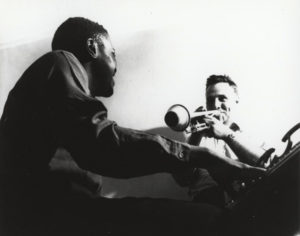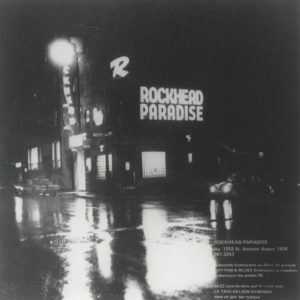
This page is also available in / Cette page est également disponible en:
Français (French)
Montreal was once a bastion of jazz. One of the first North American jazz labels was established in Montreal and enjoyed the distinction of belonging to the genre of labels then grouped as “race records.” Here is a brief history of this phenomenon and the context that gave it birth.
During the first decades of the 20th century, jazz was viewed unfavourably and associated with vice. Many in the Black community of Montreal preferred to educate their children in classical music to avoid the stereotypes upheld by whites. The saxophonist and pianist Harold “Steep” Wade is an example of a young classically trained musician who turned to jazz, specifically, its most exacting branch, bebop. He would become a pillar of the Montreal jazz scene in the 1930s and 1940s.
Prohibition
Fleeing the austerity of Prohibition in the 1920s, many American musicians set sail for Montreal, whose reputation as a fun-loving city held out the promise of a lively music scene. The city at the time was one of the few in North America not to be affected by laws restricting the consumption of alcohol, even though the Commission des liqueurs du Québec was established in 1921. Bars and hotels needed only to acquire a licence to sell beer and wine.
 In these settings, the musicians of the bayous came with their free-wheeling rhythm music to bring the dance floor to life. And local Black musicians followed suit. Montreal in a subsequent period produced some of the most famous jazz musicians in Canadian history. Pianists Oliver Jones, Oscar Peterson, Joe Sealy and Reg Wilson, saxophonist Richard Parris, drummer Norman Marshall Villeneuve and many others honed their skills in this stimulating environment.
In these settings, the musicians of the bayous came with their free-wheeling rhythm music to bring the dance floor to life. And local Black musicians followed suit. Montreal in a subsequent period produced some of the most famous jazz musicians in Canadian history. Pianists Oliver Jones, Oscar Peterson, Joe Sealy and Reg Wilson, saxophonist Richard Parris, drummer Norman Marshall Villeneuve and many others honed their skills in this stimulating environment.
Jazz finds its neighbourhood
 The St. Antoine district became the headquarters of jazz. The epicentre was the intersection of de la Montagne and Saint-Antoine, site of the Café Saint-Michel (where the African American trumpeter Louis Metcalf introduced bebop to Canada in the 1940s) and Rockhead’s Paradise. Rufus Rockhead, a Jamaican immigrant and former porter who made his fortune smuggling alcohol for Al Capone’s organization, was the first owner of a jazz club in Montreal. Rockhead’s was the best-known jazz establishment in town and a springboard to the bars of the “Upper Town,” which is to say, the bars frequented predominantly by whites, which paid higher fees. This era saw the development of a polarity between two musical scenes, one white and one black, which did not prevent more and more whites from appropriating jazz as a genre.
The St. Antoine district became the headquarters of jazz. The epicentre was the intersection of de la Montagne and Saint-Antoine, site of the Café Saint-Michel (where the African American trumpeter Louis Metcalf introduced bebop to Canada in the 1940s) and Rockhead’s Paradise. Rufus Rockhead, a Jamaican immigrant and former porter who made his fortune smuggling alcohol for Al Capone’s organization, was the first owner of a jazz club in Montreal. Rockhead’s was the best-known jazz establishment in town and a springboard to the bars of the “Upper Town,” which is to say, the bars frequented predominantly by whites, which paid higher fees. This era saw the development of a polarity between two musical scenes, one white and one black, which did not prevent more and more whites from appropriating jazz as a genre.
Ajax Records, the blues and jazz label
Ajax was founded in 1921 as a subsidiary of the first independent Canadian record-making factory, the Compo Company (1918-1971), founded in Lachine by Herbert S. Berliner, son of the inventor of the gramophone, Emil Berliner. Recordings were manufactured in Montreal and New York, and closely coordinated, but distribution was intended for the United States only. Billed as a premium “race records” label in the language of the day, Ajax Records was actually ahead of its time in terms of audio quality. It was the first label to record Montreal jazz artists like Millard Thomas and his high-profile Chicago Novelty Orchestra. African American artists like Rosa Henderson, Edna Hicks, Viola McCoy, Helen Gross, Monette Moore, Ethel Finnie, Fletcher Henderson & his Sawin’ Six and Mamie Smith also recorded there.
 To be precise, it was thanks to Smith’s success at Okeh Records that the fashion for “racial” labels gained momentum, after the famous African American composer Perry Bradford convinced the director of this New York jazz label to record Smith despite threats of boycotts by segregationist pressure groups. The success of the recording of “Crazy Blues/It’s Right Here for You,” which sold 75,000 copies, prompted a wave of similar issues by other companies. Smith, also known at the time as the queen of the blues (a title soon to be appropriated by Bessie Smith) made three recordings for Ajax in 1924 before continuing her touring in the U.S. and Europe with her group, the Jazz Hounds.
To be precise, it was thanks to Smith’s success at Okeh Records that the fashion for “racial” labels gained momentum, after the famous African American composer Perry Bradford convinced the director of this New York jazz label to record Smith despite threats of boycotts by segregationist pressure groups. The success of the recording of “Crazy Blues/It’s Right Here for You,” which sold 75,000 copies, prompted a wave of similar issues by other companies. Smith, also known at the time as the queen of the blues (a title soon to be appropriated by Bessie Smith) made three recordings for Ajax in 1924 before continuing her touring in the U.S. and Europe with her group, the Jazz Hounds.
Approaching the end
There is more to say about the historical environment around Ajax than the label itself, since it lasted only four years, its last release dating from 1925. Poor distribution in the southern and central states as well as a roster of artists who were less established than those affiliated with other record companies of the time are offered as official explanation of this hasty decline. As the Roaring Twenties ended and recording opportunities dried up for Blacks, America turned to radio, and networks hires whites to cover African American classics. Jazz clubs in Montreal continued the party until the 1950s, although segregation within the orchestras was accentuated, homogeneity being the norm.
Nevertheless, the culture of recording remains well established in the city. As jazz historian John Gilmore recounts in Swinging in Paradise, Montreal, even after Second World War, remained the only city in Canada where musicians could still make records.
This page is also available in / Cette page est également disponible en:
Français (French)














